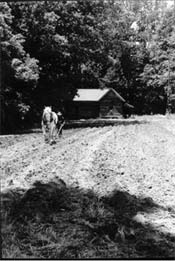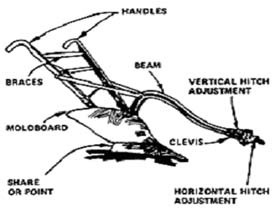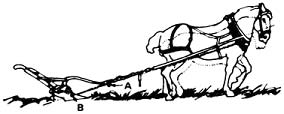 Every crop grown at the Shields-Ethridge Heritage Farm depended upon the soil. The plow was a very important tool for the farmer. It broke the soil and was pulled by mules, before the tractor was invented. The first plows were wooden, but about the time Joseph Shields began to farm here, cast-iron plows were used.
Every crop grown at the Shields-Ethridge Heritage Farm depended upon the soil. The plow was a very important tool for the farmer. It broke the soil and was pulled by mules, before the tractor was invented. The first plows were wooden, but about the time Joseph Shields began to farm here, cast-iron plows were used.
Blacksmiths made plows for different purposes, to break, flatten, or till the soil. Flattening, or harrowing was a second step in preparing to plant. Tilling was a way to weed around the growing plants. Look at the photograph. What is being done to the soil here? Now look at the diagram below. The essential parts of a plow were a share to break the ground, a moldboard to turn the soil, and a beam which attached to handles. Can you find those essential parts?
When you visit the Shields-Ethridge Farm, notice the tools on the side of the Commissary. Which do you think might be used to turn the soil? To harrow? To till?
Mules were also prized by farmers. A collar, part of the harness, fit over the shoulders of the mule. Curved bars, called “hames” hooked onto the collar. Straps, or “traces” were attached to the hame at one end, and at the other end to the swinging bar behind the mule. The harness was “hitched” to the plow with great care. The size of the mule, or horse, as shown in this diagram, guided where the plow was attached.
 Mules that were “broken to the plow” were valuable. They would turn right, if the farmer said “Gee!” They would turn left, if the farmer said “Haw!” The command “Whoa!” was probably the most welcome.
Mules that were “broken to the plow” were valuable. They would turn right, if the farmer said “Gee!” They would turn left, if the farmer said “Haw!” The command “Whoa!” was probably the most welcome.
Here’s how a farmer described plowing with his favorite mule, Buck:
“Old Buck was a sheer pleasure to plow with. The only noise was the tinkling of the trace chains and my soft commands of ‘whoa’, ‘gee’, or ‘haw.’ The birds sang so pretty and I could drink in Mother Nature in all her glory. Sure the sun was hot most of the time and made my clothes stick to my skin, but I figured it was getting the poisons out of me. That big oak at the end of the row spread out her welcoming arms, heavy with shade, and I’d pull old Buck and me into it and wind would come up from nowhere and cool us both off like air conditioning, only better. I’d feel the good the walking was doing my legs and circulation, and a sense of ‘everything’s great’ would come over me. There’s just nothing like it.” (Hard, B. Touchstone, Mother Earth News, 27, May/June 1974)
The earth, the plow, and the mule built the Shields-Ethridge Farm. During your visit you will see how the pieces of a plow work, how a mule responds to commands, and how the earth looks when it has just been turned. You will also plant cotton seed in furrows, just as your great-great-grandfather might have done.
 The smaller horse in dotted outline, requires a lower hitch at point “A” than the larger horse. Clevis must be lowered to maintain straight line from point “B” through “A” to hame.
The smaller horse in dotted outline, requires a lower hitch at point “A” than the larger horse. Clevis must be lowered to maintain straight line from point “B” through “A” to hame.
